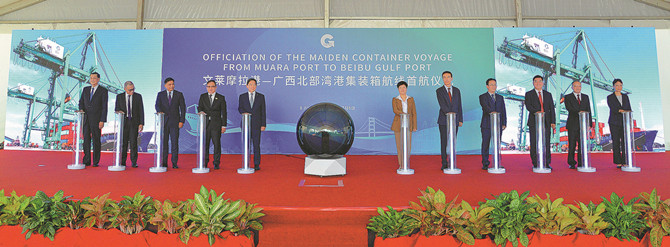[Photo/Xinhua]
NANNING — Recently, a container ship loaded with shrimp slices, melons and aquatic products departed from the seaport of Muara in Brunei to Qinzhou Port in South China's Guangxi Zhuang autonomous region, with the cargo to be delivered by rail later to Southwest China for sale.
Muara Port is Brunei's largest port, while Qinzhou Port in the Beibu Gulf is an important hub for trade and economic exchanges between China and the member states of the Association of Southeast Asian Nations.
In the past, cargo delivered between the two ports needed to be transferred via a third port, taking as much as two to three weeks or even longer. The direct container shipping route has now cut the shipping time to just one week, and reduced costs by some 30 percent, according to the Guangxi Beibu Gulf International Port Group Co Ltd.
China and Brunei have had close exchanges for centuries, and the ancient Marine Silk Road was a major trade route for both sides.
In 2013, China put forward the Belt and Road Initiative to foster new drivers for global development, injecting new impetus into economic and trade exchanges between China and Brunei.
Guangxi Beibu Gulf International Port Group and Brunei's Darussalam Assets formed a joint venture in 2017 to operate the Muara Port container terminal and bulk cargo terminal, with a total investment of 1.03 billion yuan ($142.9 million) and an operation period of 60 years.
"It quickly and efficiently injected new vitality into Muara Port and fully released the potential of the port," said Fazilah Yassin, chief operating officer of the joint venture, adding that the port has been profitable for six consecutive years, achieving an annual net profit growth of 24 percent on average.
Data showed that the Muara Port completed over 1.55 million metric tons of cargo throughput in 2022, an increase of about 20 percent over the previous year, and doubled its operating income from 2017. The number of local employees at the port has increased from 120 in 2017 to 260, with more than 96 percent of the workforce localized.
The number of container liner routes between Muara Port and the surrounding ports has increased from six to 10, and cargo trade has become more convenient and efficient, greatly accelerating the efficiency of international logistics.
In 2022, bilateral trade between China and Brunei reached a record high of $3.08 billion, according to data released by Customs authorities of China.
In addition to infrastructure, investment is expanding in many other areas, with more and more Chinese enterprises seeking cooperation and development in Brunei.
At Pulau Muara Besar, a JV between China and Brunei is the largest single foreign direct investment project in Brunei.
The refinery and petrochemical project invested by China's Hengyi Petrochemical Co Ltd produces refined products such as diesel and gasoline, and chemicals such as benzene, extending Brunei's oil and gas industry chain. The first phase of the project has an annual crude oil processing capacity of 8 million tons.
Across the sea in Guangxi, another petrochemical project of Hengyi, which is currently under construction, is expected to be operational by the end of 2024.
"We will transport the products of the Bruneian project as raw materials to produce chemical products to promote the petrochemical industrial cooperation between the two places," said Wang Tieming, deputy general manager of the company's Guangxi project.
Zhai Kun, a professor at the School of International Studies, Peking University, said that Brunei is rich in resources with a realistic demand for development, while China has a vast market and rich experience in infrastructure, industrial development and other fields.
"China and Brunei complement each other in cooperation, which is of great significance, and the cooperation model is enlightening for other countries," Zhai said.
Source:
China Daily
The opinions expressed herein are the author's and not necessarily those of The Xinde Marine News.
Please Contact Us at:
media@xindemarine.com


 Ningbo Containerized Freight Index Weekly Commentar
Ningbo Containerized Freight Index Weekly Commentar  Ningbo Containerized Freight Index Weekly Commentar
Ningbo Containerized Freight Index Weekly Commentar  Ningbo Containerized Freight Index Weekly Commentar
Ningbo Containerized Freight Index Weekly Commentar  BIMCO Shipping Number of the Week: Bulker newbuildi
BIMCO Shipping Number of the Week: Bulker newbuildi  Ningbo Containerized Freight Index Weekly Commentar
Ningbo Containerized Freight Index Weekly Commentar  Ningbo Containerized Freight Index Weekly Commentar
Ningbo Containerized Freight Index Weekly Commentar